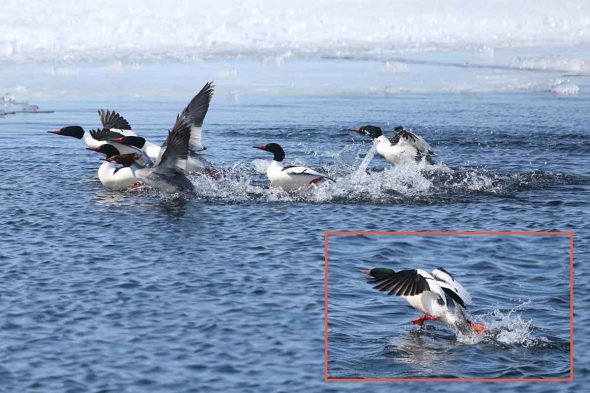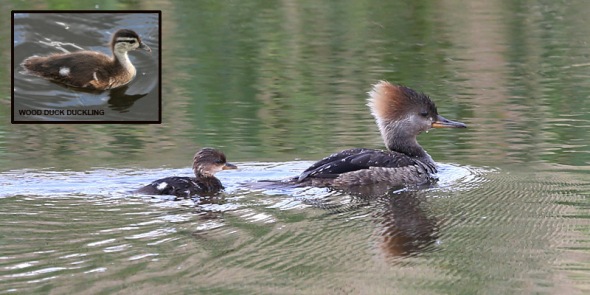Common Mergansers Taking Flight
 Most ducks can take off nearly vertically from either water or land. However, when taking off from a body of water, unless alarmed, Common Mergansers usually patter along the surface for several yards before taking flight. One would imagine that their flight might not be any more graceful than their take-offs, but the opposite is said to be true of females looking for potential nesting sites. They have been observed maneuvering easily among tree branches seeking a suitable tree cavity in which to lay and incubate their eggs, and once they have found a nest site, they appear to enter and leave their nest holes with ease.
Most ducks can take off nearly vertically from either water or land. However, when taking off from a body of water, unless alarmed, Common Mergansers usually patter along the surface for several yards before taking flight. One would imagine that their flight might not be any more graceful than their take-offs, but the opposite is said to be true of females looking for potential nesting sites. They have been observed maneuvering easily among tree branches seeking a suitable tree cavity in which to lay and incubate their eggs, and once they have found a nest site, they appear to enter and leave their nest holes with ease.
Naturally Curious is supported by donations. If you choose to contribute, you may go to http://www.naturallycuriouswithmaryholland.wordpress.com and click on the yellow “donate” button.
Hooded Merganser
 Yesterday’s mystery duckling was a Hooded Merganser. Wood Duck and Hooded Merganser ducklings are very similar, however Wood Duck young possess a dark, horizontal line behind their eyes which Hooded Merganser ducklings lack. There are several ducks that nest in tree cavities in New England, including Wood Ducks, Common Goldeneyes, Common Mergansers and Hooded Mergansers. Hooded Merganser ducklings leave their nest cavity within 24 hours of hatching, in response to their mother’s calls below. They jump/climb up the wall of the cavity and hurl themselves out of the tree. Depending on where the tree is located, they fall either onto the ground, where they bounce like a tennis ball upon landing, or straight into the water. Hooded Merganser fledglings have been known to fall as far as 50 feet to the ground and then walk as far as half a mile with their mother to the nearest body of water.
Yesterday’s mystery duckling was a Hooded Merganser. Wood Duck and Hooded Merganser ducklings are very similar, however Wood Duck young possess a dark, horizontal line behind their eyes which Hooded Merganser ducklings lack. There are several ducks that nest in tree cavities in New England, including Wood Ducks, Common Goldeneyes, Common Mergansers and Hooded Mergansers. Hooded Merganser ducklings leave their nest cavity within 24 hours of hatching, in response to their mother’s calls below. They jump/climb up the wall of the cavity and hurl themselves out of the tree. Depending on where the tree is located, they fall either onto the ground, where they bounce like a tennis ball upon landing, or straight into the water. Hooded Merganser fledglings have been known to fall as far as 50 feet to the ground and then walk as far as half a mile with their mother to the nearest body of water.
Hooded Mergansers
 A few hooded mergansers, small fish-,insect- and crayfish-eating ducks of wooded ponds, can be found year round in northern New England, but their numbers swell in March and April, when many migrant birds return to breed, and others stop over on their way further north. Standing dead trees, or snags, provide nesting cavities for these beautiful, “hammerhead” crested ducks. (Male hooded merganser on left and female on right in photograph.)
A few hooded mergansers, small fish-,insect- and crayfish-eating ducks of wooded ponds, can be found year round in northern New England, but their numbers swell in March and April, when many migrant birds return to breed, and others stop over on their way further north. Standing dead trees, or snags, provide nesting cavities for these beautiful, “hammerhead” crested ducks. (Male hooded merganser on left and female on right in photograph.)


















What Other Naturally Curious People Are Saying